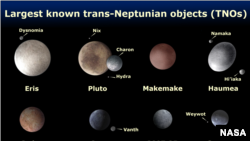Neptune is the last stop when it comes to premier real estate in our Solar System. It's nearly 4.5 billion kilometers away and it takes 165 earth years for it to orbit the sun. Beyond it, things are, as astronomers now say, 'Trans-Neptunian.'
Out in the nether reaches of the solar system, astronomers are finding trans-Neptunian objects (TNO's) fairly routinely and some of them are decidedly odd. There's the still-hypothetical "planet nine," which is much larger than the earth and influencing the orbits of the other planetoids. There's our old friend Pluto, and other wonderfully named bits and bobs like Makemake, Haumea, Orcus and Sedna.
Niku has gone rogue
But admittedly there's plenty more to find, which makes the discovery of a new TNO named Niku all the more interesting because it's wandering around in a decidedly rebellous way.
Evidence of Niku was released this week by a team of astronomers led by Ying-Tung Chen from Taiwan's Institute of Astronomy and Astrophysics and published in the journal arXiv. The team discoverd Niku by digging into results from the The Panoramic Survey Telescope and Rapid Response System 1 (PS1). According to the website, one of the major goals of the PS1 is to "discover and characterize Earth-approaching objects, both asteroids & comets, that might pose a danger to our planet."
That's where Niku first showed up, in a recently completed survery of the Outer Solar System by PS1.
The Wandering Niku
The little object is special in a lot of ways. First of all, it's in retrograde. That means it's orbiting the sun in the opposite direction of most of the other stuff in our solar system.
It also has a tremendously high inclination. What does that mean? Well, it helps to remember that our solar system is called 'coplanar.' All the planets revolve around the sun in the same basic two dimensional plane, like the rings around Saturn. A high inclination means an object is outside of this plane. In Niku's case, way outside the plane, moving in a "nearly polar orbit."
But Niku isn't alone, and that's odd as well. The team has determined there's likely at least a small group of similar, high inclination, retrograde and non-retrograde little objects floating around in our solar system. But what the team wasn't able to determine is how they got there. Usually objects like this were pushed or kicked into their odd orbits when they got too close to the the gravitational pull of other objects.
But in the case of Niku and its buddies, the team ruled out all of the obvious candidates. That suggests either there's something else out there, or that there's something going on we don't understand.
That's what makes it fun. So, stay tuned, we'll keep in touch with the scientists and let you know when they figure it out.










